| From: olddogrib
|
|
|
|
|
|
|
| Date: 01-Nov-21 |
|
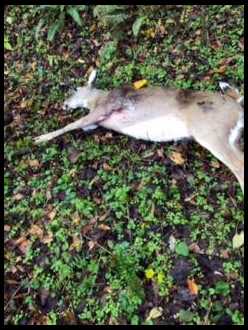
This morning I got a nice doe. The arrow went in low right behind the elbow broadside. She did the "mule kick" with both hide legs and I immediately thought "heart shot, dead deer". About that I was correct. It was a pass through, but the blood on the arrow was not encouraging in regards to quantity or color. About 1/4 of the heart had been sliced completely through when I field dressed it. The inlet/exit wounds were both large. The chest cavity was flooded, yet I could find none on the ground. The part that amazed me was that it went over 100 yards and I have yet to find blood other than the pool she was laying in. I even back- tracked a ways and picked up squat. My question is can you hit heart and miss lungs. In the diagrams I've studied some have the lungs completely covering the heart. Other its slightly exposed. Maybe it depends on the inhale/exhale, but after this experience I'll take the double-lunger every time! I'll try to attach the pic but it was taken with a cellphone, so all bets are off...i.e. I'm no technoweenie!
|
|
| From: MikeT
|
|
|
|
|
|
|
| Date: 01-Nov-21 |
|
Strange things happen. Nice deer.
|
|
| From: Geezer
|
|
|
|
|
|
|
| Date: 01-Nov-21 |
|
YOu never know how they will react. Glad you got it.
|
|
| From: GUTPILEPA
|
|
|
|
|
|
|
| Date: 01-Nov-21 |
|
I had the complete opposite of you I shot a doe thru the heart the blood trail was so heavy Stevey Wonder could have followed it I never see so much blood
|
|
| From: JusPassin
|
|
|
|
|
|
|
| Date: 01-Nov-21 |
|
Took a doe a few years ago with a steep full pass through heart shot. Got the big kick and watched her run over 200 yards through a cornfield before she fell. Little blood trail. I would much prefer a double lung hit.
|
|
| From: fdp
|
|
|
|
|
|
|
| Date: 01-Nov-21 |
|
Typically in my experience there is more blood on the ground from a double lung sho.
|
|
| From: SB
|
|
|
|
|
|
|
| Date: 01-Nov-21 |
|
You damage the pump...it don't pump!
|
|
| From: Kwikdraw
|
|
|
|
|
|
|
| Date: 01-Nov-21 |
|
Shot a buck Sat., out of a 16' tripod in a whispy mesquite. 18yds. Went in about 3" below the backbone, quartering away, came out low below the opposite shoulder, just under the skin. No blood whatsoever, heard him crash, went 30yds, hit the ground dead. Amazing! Caught one lung and the heart. Lethal, but no blood!
|
|
| From: DanaC
|
|
|
|
|
|
|
| Date: 01-Nov-21 |
|
In the several seconds before a heart shot kills, a deer can go a ways. Depends how fast they run. Punched a 20 gauge slug right through the heart of a spike once, was astonished to watch him walk away. He didn't walk far, but...
|
|
| From: Sawtooth (Original)
|

|
|
|
|
|
|
| Date: 01-Nov-21 |
|
Once you turn the string loose anything can happen. I’ve had heart shots with good blood: and heart shots like you describe. Who knows? I like a quartering away shot over broadside because normally I damage more than just the heart. When those wind bags are cut it’s like wringing out a sponge.
|
|
| From: Corax_latrans
|
|
|
|
|
|
|
| Date: 01-Nov-21 |
|
You absolutely cannot hit the heart without hitting lungs.
But if the arrow passes through the meaty parts of the shoulders, there is less resistance for the blood to pool inside the cavity than to squeeze through a slit in the meat to hit the ground.
Also the holes through the shoulder muscles are only lined up with the holes through the ribcage at one point during each stride, whereas you hit aft of the shoulder and you can practically look right through to the other side. And every stride/breath they take blows blood onto the trail.
So yeah…. Easier to get a good blood trail from the DL. Especially when you Do get an exit vs Don’t. and the second hole is more likely when you mess up less meat.
|
|
| From: Corax_latrans
|
|
|
|
|
|
|
| Date: 01-Nov-21 |
|
Well. I thought about throwing in the qualifier, but then there’d be nothing to bicker about, so…..
Just doing my part to keep the conversation lively!
LOL
|
|
| From: bowhunt
|
|
|
|
|
|
|
| Date: 02-Nov-21 |
|
A full speed all out sprint death run could limit the amount of blood on the ground as well.
|
|
| From: olddogrib
|
|
|
|
|
|
|
| Date: 02-Nov-21 |
|
I didn't mention that the arrow had that "tallowy" feel, so it likely clipped a rib or sternum and possibly got "wiped" clean. the picture is deceptive with the deer on its side, the entry was lower standing up. I have lots of heart shots in 45 years of hunting....this one was admittedly atypical. Oddly, the best blood trail I've ever had was my first long bow buck and an "accidental" shot. It had a small buck was built like a horse. It was severely quartering away and I was going to give it a pass. I was just going to draw, line up the shot, "count coup" and let down. When everything looked good the string just slipped off my fingers! The arrow entered beside the spine, 3/4 of the way back toward the hams. I felt physically sick to watch that deer run off with arrow still sticking out its back...until I got to the spot. The arrow had penetrated enough to catch the off-side lung and it looked like somebody filled a garden sprayer. That deer probably went 700-800 yards and following it I never lost the blood trail painting the landscape out the hole in its back. The good news it was all downhill and it piled up within easy dragging distance of the road, but it weighed a ton. I was amazed to have found the intact arrow early on and always scratched my head until later on when I watched relaxed deer "groom" themselves and saw how far down their back they can reach.
|
|
| From: 2Wild Bill
|
|
|
|
|
|
|
| Date: 02-Nov-21 |
|
My first thought was the angle of escape may have caused the blood to be retained in the body, rather than forming at the hole and sprayed out. Was it uphill or downhill from the point it was hit? With the hole so far forward, I'm guessing uphill to the point where she dropped.
|
|
| From: hawkeye in PA
|
|
|
|
|
|
|
| Date: 02-Nov-21 |
|
I'm curious on the OP's blade configuration of the broadhead used with out trying to deride the thread. I'm partially color blind and I favor a three or four blade broadhead for blood trails. I'm not trying to say a two blade doesn't work at all EITHER. Over the last fifty some years I have come to appreciate Fred's razorhead concept with the breakable bleeder.
|
|
| From: reb
|
|
|
|
|
|
|
| Date: 02-Nov-21 |
|
Lung hit any day.
|
|
|
|
| From: Corax_latrans
|
|
|
|
|
|
|
| Date: 02-Nov-21 |
|
“ A full speed all out sprint death run could limit the amount of blood on the ground as well.”
Do the math: If the animal is bleeding out (externally) at 1 ounce/second and moving at 60 fps (about 40 mph), then that blood will be distributed across about 60 feet of trail for every second it runs .
Heart-shot animals seem to run flat-out, and since they are probably starting to black out very quickly, they aren’t thinking about cover , just speed. That seems to apply to any animal that has been hit well and is bleeding out very quickly.
The one thing that can cause them to deviate from a straight line is if one shoulder has been more damaged than the other by the Broadhead, in which case they lose power on that side and their trail will tend to arc in that direction.
Pay attention to last sight vs last sound for a clue on that.
And learn to trail without blood. Use the blood that you do find to tell you where to look for all of the other kinds of sign that they leave.
“So easy… A caveman can do it.”
|
|
| From: hawkeye in PA
|
|
|
|
|
|
|
| Date: 02-Nov-21 |
|
Personally I'll discredit the down hill and towards water theory. Over the years I've seen many try to make it towards their security area, quite often a advantage point. Some may run towards a creek only to try get up the other side to further the distance from you.
|
|
| From: Live2Hunt
|
|
|
|
|
|
|
| Date: 02-Nov-21 |
|
I've had heart shot deer drop in there tracks, seems most heart shot deer do not bleed much right away because you stopped the pump. I just shot one through the heart like the OP's and I was able to see it go down after 100 yard + dash and stop. I noticed, not much blood on the way to her. Had one a few years ago we had hell of a time with, no blood at all to speak of. Had to have my buddy stand at the shot with a flashlight as I just started walking the direction she went. There she was about 80 yards dead, with blood all over the spot she dropped. My favorite hit is above and forward of the heart. It leaves a carpet to follow.
|
|
| From: Buckeye
|
|
|
|
|
|
|
| Date: 02-Nov-21 |
|
The heart is a pump with an inlet and outlet, take out the outlet and most likely there will be a great trail. the inlet, not so much.
|
|
| From: JimG
|
|
|
|
|
|
|
| Date: 02-Nov-21 |
|
When a deer is shot, bow or gun, and assuming a CNS hit has not occurred (spine or brain) the deer will run/trot/walk a distance. Quantity of blood to trail the deer is not always a given. The old general rule of thumb of 'double lung/heart shot and dead within 100 yards' is often broken.
Example- Sunday morning I shot a 2.5 year old doe standing broadside at 20 yards. The 3 blade head went through both lungs and one blade of the broadhead put a significant slice in the heart. Arrow was sticking in the dirt. Blood on arrow from tip to nock. Deer ultimately went 200 plus yards. Deer never ran. Walked away from me due east on the edge of a mowed tractor lane and soybean field then turned 90 degrees due north into a dense thicket. There was not a drop of blood to be seen until a good 100-125 yards into the deer's path of travel. Then it turned into a literal bloodbath. The kind ole Stevie Wonder could follow. Deer was found lying in a several foot circle of blood covered leaves. In my opinion there should of been a good blood trail to follow right from the start. There was not.
Moral of the story is never assume anything. Old rules of thumb and previous experiences can guide you to future success but there will always be an animal who decides to break the 'rules' and test your tracking abilities.
|
|
| From: JimG
|
|
|
|
|
|
|
| Date: 02-Nov-21 |
|
I should add that I could see the deer the entire time it walked away from me until it entered the thicket.
|
|
| From: Archer22
|
|
|
|
|
|
|
| Date: 02-Nov-21 |
|
I've had the same experience: All of the heart shots I've made, there was very little blood. However, lung shots usually leave a pretty nice trail.
One time I hit the artery below the spine, just above the liver, WOW. It looked like a crime scene, blood sprayed for several feet. That doe still made it 40 yards, but there was blood all over the place. It was almost embarrassing because that deer ran down next to a county road in a cut corn field. She kept falling down and trying to get up. There was a 12ft circle around where she fell that was covered in blood. Never seen anything like it before or since that deer. A neighbor drove by while we were gutting her and said "What the hell did you do to that deer?!" I'll never forget it.
|
|
| From: olddogrib
|
|
|
|
|
|
|
| Date: 02-Nov-21 |
|
For those that asked the shot was from a ground blind level with the deer, the exit was all angling downhill. I really didn't have any trouble finding her, I knew where she was headed...a side-hill trail running below the ridgetop, where she piled up as soon as she got on it. I spotted her from about 30 yds. above, I just took working my way down to her looking for blood. The head was a wide two-blade. In my crappy pic your looking at the entry side...the exit wound was an awesome gash! I should have taken a pic of the slashed heart, but it was pickled along with my first's of the season today!
|
|
| From: wooddamon1
|
|
|

|
|
|
|
| Date: 02-Nov-21 |
|
Mmm pickled heart. My very first deer ever was a doe I shot through the heart from above, looked like someone ran to her spilling a bucket of red paint on either side of her path. Then the big red spray circle around her like was mentioned. She went about 50 yards in a straight line. Another doe I heart-shot ran into a tree and flopped over dead. Actually had that happen twice, only the second time was a lung shot a few years later.
|
|
| From: Corax_latrans
|
|
|
|
|
|
|
| Date: 02-Nov-21 |
|
One thought on the old line about them heading for water when wounded…
If they live long enough to get thirsty, then yes, they will head for water. If they are running in a blind terror, they’re not going to think about stopping off for a drink on their way.
If they are hit hard enough to make them feel genuinely sick, but they are not particularly frightened by the sound of the shot or the plunk of the arrow, then it stands to reason that they would start to look for a nice, quiet place in thick cover to go lie down for a spell. Probably the only animal harder to recover than that would be one that took a long time to start feeling sick.
Shots tight under the spine can open up the descending aorta, which is better than getting both femoral arteries at once, because it’s higher pressure. Not really something you can plan on aiming for, though…
But they don’t go down until BP=0 or the brain runs out of oxygen; if you were to sprint on one lungful of air, you’d get some appreciable distance before you blacked out. And if you could run at 40 miles an hour, you would get a whole hell of a lot farther.
Really, it’s amazing to me that they typically go down as quickly as they do. You would think that with collapsed lungs, they would need a good minute.
But as we all learned from watching cowboys and Indians movies as kids, an arrow to the chest knocks you out immediately!! LOL
I have said this before here… I know a guy who was a professional deerstalker in the UK who has literally shot thousands of deer with various rifles over the years, and his favorite was a .270 Winchester with a 150 grain bullet loaded to 2800 FPS. On a solid double-lung hit tight to the shoulder, he fully expected every deer to run a minimum of 80 yards. I figure anytime we get one that goes less than 100, we have done excellent work.
|
|
| From: bentstick54
|
|
|
|
|
|
|
| Date: 02-Nov-21 |
|
From my experience I will take a double lung shot over a heart shot every time. Seems to give a better blood trail more often, and they usually go down in a shorter distance. My personal experience, lack of oxygen combined with severe blood loss through the lungs has always given me better and shorter blood trails.
|
|
| From: Altitude Sickness
|
|
|
|
|
|
|
| Date: 03-Nov-21 |
|
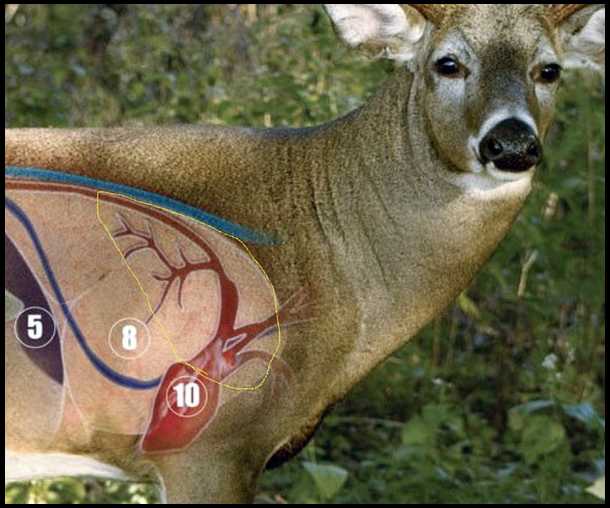
The heart muscle can be hit and will still pump some blood for a while. The reason many like the lung better. Or It would be more accurate to say high heart forward, middle lung is best. But close to bone
Because has the most dense area of blood vessels. Also why a frontal shot drains them so fast.
|
|
| From: Altitude Sickness
|
|
|
|
|
|
|
| Date: 03-Nov-21 |
|
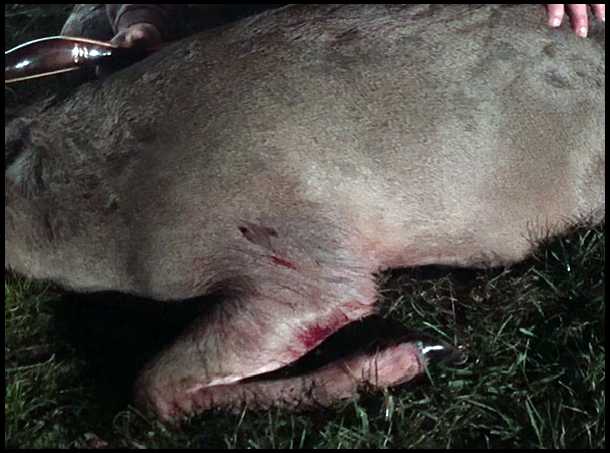
This shot was in the top of the heart area. Looks low in this pic from the leg not being extended properly. It was a very good trail to follow, from a small 2 blade.
|
|
| From: Altitude Sickness
|
|
|
|
|
|
|
| Date: 03-Nov-21 |
|
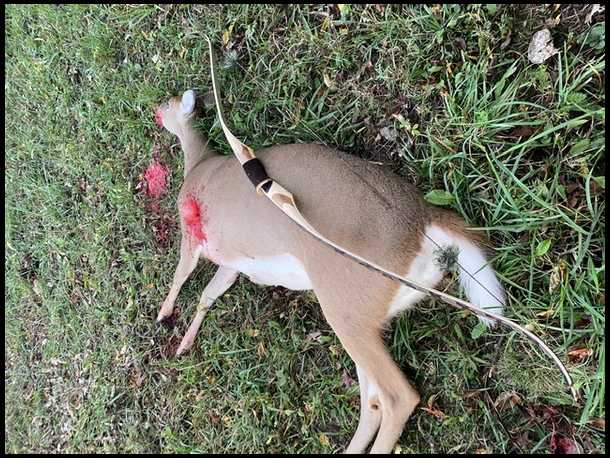
Another in the pocket. Top of heart towards front of lungs. It does crowd the leg bone though. Only works on a even or low shot angle and confidence in the shot. 40 yard retrieval
|
|
| From: Altitude Sickness
|
|
|
|
|
|
|
| Date: 03-Nov-21 |
|
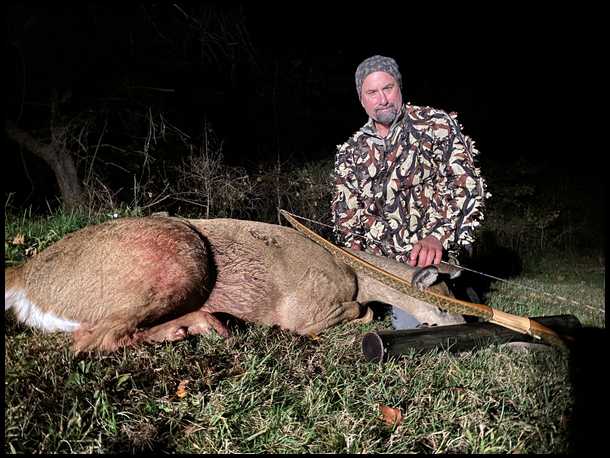
More forgiving and still reliable but not as good of trail and a longer track is the quartering away.
|
|
| From: static
|
|
|
|
|
|
|
| Date: 03-Nov-21 |
|
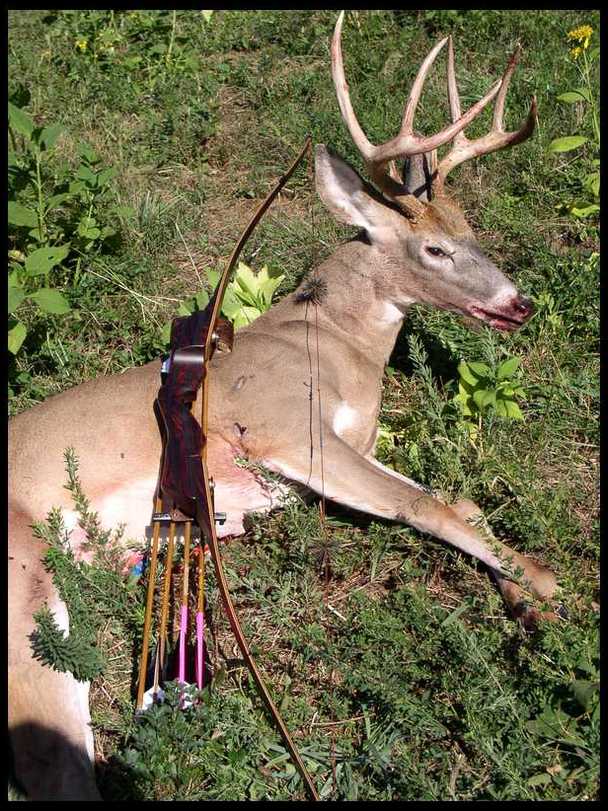
3 blade, painted the ground red. Notice the lack of blood around the mouth and nose, Why? because the Snuffer created a massive entry wound channel that dumped all the blood out of the animal onto the ground!
|
|
| From: Altitude Sickness
|
|
|
|
|
|
|
| Date: 03-Nov-21 |
|
Nice shot static. Hey I like that fletch combo. Pink to catch the eye when looking for an arrow. Mainly black to not flag too much alerting game. And the white rear fletch to see where the arrow hit.
|
|
|
|
|
|
| From: olddogrib
|
|
|
|
|
|
|
| Date: 03-Nov-21 |
|
Okay, that's what I'm talking about. In Altitude Sickness' diagram the majority of the heart is exposed enough for a complete lung miss and I've seen many that concur, while others show the entire heart hidden behind the lungs...what gives? Will the "deer anatomy expert" pleas step forward, lol!
|
|
| From: Corax_latrans
|
|
|
|
|
|
|
| Date: 03-Nov-21 |
|
They don’t depict the lungs over the heart so that you can see where it IS.
But the lungs are wrapped around the heart, filling every nook and cranny in there. There is no wasted space. Heart sits in there like the pit of a plum. You can hit the plum with hitting the pit, but you can’t hit the pit without going through some plum.
|
|
| From: Andy Man
|
|
|
|
|
|
|
| Date: 03-Nov-21 |
|
Corax_latrans X 2
|
|
| From: Corax_latrans
|
|
|
|
|
|
|
| Date: 03-Nov-21 |
|
“You can hit the plum withOUT hitting the pit, but you can’t hit the pit without going through some plum.”
Drat.
|
|
| From: shade mt
|
|
|
|
|
|
|
| Date: 04-Nov-21 |
|
Good bloodtrails are what we hope for.
But anyone that has bowhunted long enough and shot enough animals eventually has to track with little or no blood.
Deer that take off on a death run are fairly easy to track.
Deer that just walk off are not so easy.
All mortally wounded deer leave a trail, even if there is little blood.
If anyone cares to argue that fact, find a good African tracker and discuss that with them, some of those men are amazing.
A deer that runs off leaves a trail of disturbance,... we all know....ruffled up leaves right?. But the woods are full of ruffled up leaves, especially in fall when they are dropping.
What your looking for is leaves with dirt on them, or decayed leaf matter on them, neither of which newly fallen leaves have.
Broken twigs, not just any broken twigs, freshly broken twigs, there is a difference. also twigs and pieces of debris out of its original place. Bent over vegetation..etc
All animals disturb the ground when foraging, squirrels, turkey ,deer etc...But it will be random. What your looking for is a trail of disturbance.
One other point is the trail often is not nearly as obvious when you look at it backwards. When tracking without blood you need to go slow and look with your eyes and try to stay focused in the same direction of the track. Walk carefully trying not to disturb the ground anymore than you have to.
Way to many guys call there buddy's when there is no blood, or start blundering around and ruin any trail there was.
For me anyhow...a grid search is a last resort...id much rather, grub out the track.
I just tracked one last weekend in the rain, found about two little drops of watered down blood. It was thick enough where it ran that it would have been easy to walk by...grubbing out the track was the key.
I want to stress once again your looking for a trail of disturbance...and you want to be looking at it from the right direction, it will not be as obvious looking at it backwards.
I want to
|
|
| From: 782GearUSMC
|
|
|
|
|
|
|
| Date: 04-Nov-21 |
|
Alas! The bloodless and blood-ending trails.
Too many bowhunters tend to believe that all mortally wounded deer will leave a blood trail that continues to where the deer has expired. Regretfully, so untrue.
Now the grueling task of locating and following a trail begins. If your post-shot tracking knowledge and ability is limited to following a blood tail, the likelihood of finding the deer is...unlikely.
A few things, just a few things, to know to increase odds of finding a hit deer deer that has not left a visible blood trail.
1. Not set in stone, but it will likely not run to unfamiliar territory. However, its familiar territory (home range) could be a mile or two from where you hit it. Knowing where they commonly travel and their bedding areas is a plus.
2. Fleeing deer, including wounded deer, don’t always run in a straight line for great distances from where it was spooked or hit. I have had hit deer run from where I hit it, run straight out 50-100 yards then suddenly circle/curve back and drop dead within eyesight or heard it crash nearby.
3. A blood trail is not always on the ground. A hit deer might blow or rub/drop blood on brush, low-hanging limbs, trees, etc, 3-4 feet above ground.
4. If not pushed too early, a common mistake, a badly wounded deer will often harbor up in trash earlier and closer by then you might not expect it too. They know they are now vulnerable to predators and instinctively will go for thick cover.
I once watched my nephew's gut-shot doe run across a harvested bean field that was about 100 yards in width into a wood-line. When I tracked her to the wood-line I saw there was a large fall that had fallen onto a ditch just at the edge of the woods, I crawled under the fall and she was under the fall as far back as she could crawl.
On another occasion I hit a buck in just his lungs (later determined). He only left a few spots of blood for a very short distance. I tracked his trail in the mud and leaves and determined that he had circled back within 50-60 yards from where I had hit him and had ran across a wide harvested cornfield. I knew there was a very large fall across the field near a creek about 300 yards away.
I waited for 3 cups of coffee and couple of beef jerkys, then crossed the field and came in down-wind of the fall. As I approached the fall, he exploded from beneath a bunch of limbs but was entangled. As he fought to get loose he collapsed and died. Getting him out, even with help, was a real chore.
5. shade mt is spot on with his advice. However, keep in mind that a bounding deer won’t leave a continuous trail. The one method I always use when tracking a wounded deer is I carry a couple rolls of toilet paper, it’s biodegradable, and will continually hang strips as I track. Very beneficial if you have to backtrack and start over. Another plus is that the trail of toilet paper tends reveal where the deer may behead for and visibly indicates changes in direction of travel.
6. Lastly, contrary to what some believe, a wounded deer can and will run up hills. I have hunted old strip mine areas with slopes 50-60 feet high and have watched wounded deer run up the slopes.
|
|
| From: pdk25
|
|
|
|
|
|
|
| Date: 04-Nov-21 |
|
Never heart shot an animal that I didn't recover. Rarely aim specifically for the heart because I like some room for error. Worse problems to have.
|
|
| From: 2Wild Bill
|
|
|
|
|
|
|
| Date: 26-Nov-21 |
|
Beauhunterrick, Wild Bill I find it very rare for a mortal he hit deer to run uphill for any distance they typically go downhill in my experience "
That is a frequent saying.
I would say that most of my bowhunting experience is on a hillside. The odds are 50/50 up or down, and in my experience at least half go up. Deer are notorious for not following rules.
bentstick54,
"lack of oxygen" That's because the the hole/holes in the lung cavity draw air in and around the lungs and not down to inside the lungs from the nose or mouth, suffocation.
|
|
| From: bentstick54
|
|
|
|
|
|
|
| Date: 26-Nov-21 |
|
Yes 2Wild Bill, and because of that they won’t go very far. And the heart is still pumping blood through those same holes.
|
|
| From: Chairman
|
|
|
|
|
|
|
| Date: 27-Nov-21 |
|
My younger brothers first deer was hit right across the top of the heart cutting both lungs. He was close and adamant it was perfect and it was but still probably 60 yards before any blood. She ran straight uphill very steep and fell over backwards 200 yards away. No death run.
|
|
| From: Corax_latrans
|
|
|
|
|
|
|
| Date: 27-Nov-21 |
|
So what would you call the 200-yard dash??
|
|
| From: Chairman
|
|
|
|
|
|
|
| Date: 27-Nov-21 |
|
Not sure of the question but the deer hopped a fence and bounded away not apparently in any hurry. Most deer I have hit in the heart run with their body low no bounding, hence the name death run, you know where you hit them . This girl acted unhit and didn’t leak for quite aways.
|
|
| From: Corax_latrans
|
|
|
|
|
|
|
| Date: 27-Nov-21 |
|
Ah. Good detail. That IS the first time I’ve heard of an animal hit that hard that didn’t act hard-hit!
|
|
| From: 782GearUSMC
|
|
|
|
|
|
|
| Date: 27-Nov-21 |
|
It is a misconception by many that a mortally hit deer will always leave a blood trail. Not true.
Last week when my nephew killed his buck, he hit both lungs and sliced its heart with no pass through. The buck made it a good 100-150 yards before it fell to the ground. Zero blood trail to where it fell. In fact, when I got to the buck, there was not much blood on the ground where it lay, and no blood in its nostrils or mouth. When he hung and opened the buck, buckets of blood cascaded from the buck.
I suspected that would be the result, because while the buck was lying on the ground he looked like a late pregnancy doe. He had bled out internally.
|
|
| From: Corax_latrans
|
|
|
|
|
|
|
| Date: 27-Nov-21 |
|
Same result on a 2-shoulder heart hit. Zero blood save a pinhead’s worth there where the arrow snapped off.
Lucky I saw him go down.
|
|
| From: GLF
|
|
|
|
|
|
|
| Date: 27-Nov-21 |
|
Hit a major blood vessel ya get good blood and short run, vessels feeding the heart muscle not so much. It's pretty easy to miss the major vessels with a 2 blade and get long trails. I use 2blade heads but 3 or full 4s will hit a major vessel every time and give short trails.
|
|
| From: 782GearUSMC
|
|
|
|
|
|
|
| Date: 27-Nov-21 |
|
GLF said: "...but 3 or full 4s will hit a major vessel every time and give short trails."
That would be great if that held true every time, but I don't know of any broadhead that you can count on to always "hit a major vessel every time and give short trails.
That being said, I am using a 125 grn Magnus "Snuffer" 3-blade broadhead this season. Not because I believe they are guaranteed to ALWAYS be more lethal vs. a 2-blade, but because I had a dozen unused ones and I am not ready to field test a new type and brand of 2-blade broadhead I recently purchased.
2-blade broadheads are easier to sharpen, and it's my contention that a 2-blade will afford better penetration, not to say that a 3-blade penetrates poorly.
|
|
If you have already registered, please sign in now
For new registrations Click Here
|
|
|
|



